|
|
|
Sort Order |
|
|
|
Items / Page
|
|
|
|
|
|
|
| Srl | Item |
| 1 |
ID:
150222
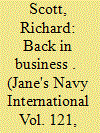

|
|
|
| 2 |
ID:
105207


|
|
|
| 3 |
ID:
137502
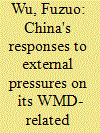

|
|
|
|
|
| Summary/Abstract |
China, although a member of most of the international non-proliferation and multilateral export control regimes and having a law-based comprehensive export control system, has not fully complied with its non-proliferation obligations, which is evidenced by not only the US's sanctions on some Chinese entities for their weapons of mass destruction (WMD) related exports but also some external disclosures in this regard. Faced with these external pressures, China's responses have been both reactive and proactive. The rationale for China's mixed responses can be attributed to its security interest in preventing nuclear terrorism, geopolitical interests in South Asia, economic interests in procuring oil supplies, high-tech imports and missile export markets, in addition to its status interest in building a ‘responsible great power’ identity in the international community.
|
|
|
|
|
|
|
|
|
|
|
|
|
|
|
|
| 4 |
ID:
126205


|
|
|
| 5 |
ID:
122458
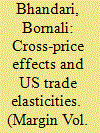

|
|
|
|
|
| Publication |
2013.
|
| Summary/Abstract |
This article examines the interactions of the import and export markets through cross-prices. The idea is that import demand is affected by export prices, because imports and exports are likely substitutes in consumption. Additionally, import supply is also affected by export prices as exports may be intermediate inputs in the production of imports. The traditional partial equilibrium model of trade is extended to include these cross-price effects in demand and supply. Theoretically, it is shown that these cross-price effects can impede trade balance adjustment in the presence of exchange rate and income shocks. Using quarterly US and rest-of-the-world data from 1975 to 2002, a fully modified general method of moments estimation of the structural equations demonstrates significance of cross-price effects in both the demand and supply of non-petroleum merchandise imports.
|
|
|
|
|
|
|
|
|
|
|
|
|
|
|
|
| 6 |
ID:
114793
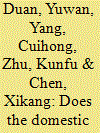

|
|
|
|
|
| Publication |
2012.
|
| Summary/Abstract |
Since 2001, the exports of foreign-invested enterprises (FIEs) have accounted for more than 50 percent of China's total exports. As foreign capital occupies a high proportion of the total capital of FIEs, most FIEs' capital gains are foreign factor income. Although these gains are calculated as a part of China's GDP, they do not belong to China's national income. To determine the real contribution of exports to China's welfare, the present paper analyses the impact of exports on China's national income using a non-competitive input-output model capturing processing trade. The results show that every US$1000 of China's exports generates US$506.8 of national income. The real contribution of exports to China's welfare is much smaller than what we expected. This suggests that China should endeavor to improve the gains from international markets or find another engine to maintain its economic growth.
|
|
|
|
|
|
|
|
|
|
|
|
|
|
|
|
| 7 |
ID:
160863
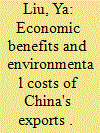

|
|
|
|
|
| Summary/Abstract |
This paper decomposes economic benefits (value‐added) and environmental costs (CO2) of exports according to their sources, and maps the global value network (GVN) and the global emissions network (GEN) for China's exports during 1995–2009 from national, sectoral and national–sectoral perspectives. A comparison is conducted between China and the USA. National GVN and GEN show that shares of value‐added and CO2 emissions from China in its GVN and GEN both decreased first then increased after 2006, while shares from the USA in its GVN and GEN generally decreased. Sectoral GVN and GEN show that among China's exports, “electrical and optical equipment” and “electricity, gas and water supply” were, respectively, the sectors that obtained the most value‐added and emitted the most CO2. National–sectoral GVN and GEN for China exhibited reciprocal and disassortative patterns, and in‐strengths and out‐strengths of GVN and GEN for China's exports were mainly captured by several domestic country–sector pairs.
|
|
|
|
|
|
|
|
|
|
|
|
|
|
|
|
| 8 |
ID:
170172
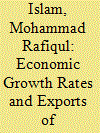

|
|
|
|
|
| Summary/Abstract |
Global images of Bangladesh as a desperately poor country in need of foreign aid require revision in light of recent statistics that confirm impressive economic growth rates despite protracted political problems and climate-related risks. The article presents and discusses statistical evidence relating to recent economic growth rates of Bangladesh in terms of export, import and gross domestic product. This confirms the status of the country as a new tiger economy, moving away from its traditional dependence on agriculture. However, excessive reliance on exports of ready-made garments is found to be risky, while a more balanced growth model with a diverse basket of exports seems advisable.
|
|
|
|
|
|
|
|
|
|
|
|
|
|
|
|
| 9 |
ID:
120215
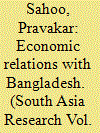

|
|
|
|
|
| Publication |
2013.
|
| Summary/Abstract |
Since 1971, India was the major trading partner of Bangladesh. However, China's trade with Bangladesh has increased manifold in recent years to surpass India from 2004 onwards. This slowing down and change of economic relations between India and Bangladesh, coupled with strained and uncertain political relations, raise multiple concerns. This article examines the various factors that have contributed to China's growing presence in Bangladesh as compared to India's decline with respect to trade and investment. India has clearly lost out to China in many important industries. While reviewing and assessing recent developments, the study also presents a strategy to counter India's declining economic influence in Bangladesh.
|
|
|
|
|
|
|
|
|
|
|
|
|
|
|
|
| 10 |
ID:
100965
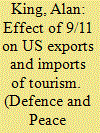

|
|
|
|
|
| Publication |
2010.
|
| Summary/Abstract |
Several studies have investigated whether the terrorist attacks of September 11, 2001, have had an ongoing or merely transitory effect on US trade in tourism. All conclude in favor of the latter. However, limitations in either the data and/or methodology employed by these studies give cause to query their findings. The present study avoids these limitations and finds strong evidence that, once other factors are held constant, real US exports and imports of tourism have both remained significantly below their pre-2001 level.
|
|
|
|
|
|
|
|
|
|
|
|
|
|
|
|
| 11 |
ID:
104942
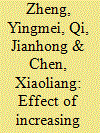

|
|
|
|
|
| Publication |
2011.
|
| Summary/Abstract |
Given China's heavy reliance on fuel energy and the dominance of its industrial sector in the economy, improving energy efficiency remains one of the practical means for the country to decrease energy intensity and to fulfill its commitment made at the Copenhagen Climate Change Conference to achieve a 40-45 percent reduction in CO2 emission intensity by 2020. This study investigates the impact of exports on industrial energy intensity to explore the possibility of reducing energy intensity through greater exports. A panel varying-coefficient regression model with a dataset of China's 20 industrial sub-sectors over 1999-2007 suggests that in general, greater exports aggravate energy intensity of the industrial sector and that great divergences exist in the impact of exports on energy intensity across sub-sectors. A panel threshold model further estimates the thresholds for the major determinants of energy intensity: exports, input in technological innovations, and Foreign Direct Investment (FDI) intensity. Given the great differences in specific sub-sector characteristics and the changing roles played by different factors across sub-sectors, there is no general export policy that would work for all sub-sectors in reducing sub-sector energy intensity. Instead, policies and measures aiming to encourage more efficient use of energy should take into full consideration the characteristics and situations of individual sub-sectors.
|
|
|
|
|
|
|
|
|
|
|
|
|
|
|
|
| 12 |
ID:
092549


|
|
|
|
|
| Publication |
2009.
|
| Summary/Abstract |
The increase in oil prices in recent years has occurred concurrently with a rapid expansion of Chinese exports in the world markets, despite China being an oil importing country. In this paper we develop a theoretical model that explains the positive correlation between Chinese exports and the oil price. The model shows that Chinese growth can lead to an increase in oil prices that has a stronger impact on its export competitors. This is due to the large labor force surplus of China. We then examine this hypothesis by estimating a reduced form equation for Chinese exports using Rodrik [Rodrik, Dani, 2006. What's so special about China's exports? China and World Economy 14, 1-19.]'s measure of export competitiveness, together with the oil price, productivity, real exchange rate, and foreign industrial production over the monthly 1992-2005 period. The results suggest a stable relationship and yields slightly positive values for the price of oil and elastic coefficients for export competitiveness, along with the expected negative elasticity for the real exchange rate.
|
|
|
|
|
|
|
|
|
|
|
|
|
|
|
|
| 13 |
ID:
129227


|
|
|
| 14 |
ID:
128838


|
|
|
|
|
| Publication |
2014.
|
| Summary/Abstract |
This paper presents empirical results on the export performance of Spanish defense contractors. The objective is threefold. First, we briefly describe the export profile of the Spanish defense industry at the firm level. Second, in light of some results on the determinants of firm-level export intensity, we empirically test some of these variables for the case of defense-related exports. We find that exporters tend to be capital intensive, diversified, and showing high R&D effort. In the analysis by sectors, learning by exporting is the most frequent result. Third, we assess the exporter productivity premium, regressing productivity on exporter status and firm size. Our results indicate that when controlling for firm heterogeneity, no such premium exists.
|
|
|
|
|
|
|
|
|
|
|
|
|
|
|
|
| 15 |
ID:
164422
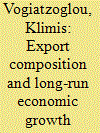

|
|
|
|
|
| Summary/Abstract |
Export expansion can be a significant engine of economic growth for developing economies. The size of the growth effect of exports depends not only on volume but also on the sectoral composition of exports. By explicitly considering the sectoral export composition, this article examines over a 31-year period the long-run growth impact of exports in four transition and emerging economies of the Association of Southeast Asian Nations (ASEAN), namely Cambodia, Laos, Myanmar and Vietnam. More specifically, for each country, a long-run equilibrium analysis within a cointegration framework is conducted for three broad sectors (agriculture, mining/natural resources and manufacturing) as well as for 22 manufacturing industries during 1987–2017. The results indicate that there has been sizeable export expansion (especially in Vietnam), but export composition differs substantially across economies, which has an effect on the overall growth impact of the country’s exports. Clear evidence of export-led growth is found only for some sectors. Countries that rely heavily on primary goods have experienced relatively lower export-led growth. Export restructuring in manufacturing industries is associated with a larger long-run growth effect for a country’s exports. Our findings suggest that policies encouraging diversification away from traditional export sectors would be expected to lead to higher long-run growth effects of exports. Furthermore, our analysis implies a steady strengthening of export dynamism in ASEAN ‘latecomer’ economies and their rising significance in the global trade system.
|
|
|
|
|
|
|
|
|
|
|
|
|
|
|
|
| 16 |
ID:
112502


|
|
|
|
|
| Publication |
2012.
|
| Summary/Abstract |
There has been considerable concern in Latin America over the implications of increased competition from China for local industry. These concerns include the possibility of "deindustrialization," the increased "primarization" of the region's exports and the difficulties of upgrading manufactured exports into higher technology products. This article examines the impact of Chinese competition both in the domestic market and in export markets on Brazilian industry. It documents the increased penetration of Chinese manufactures in the Brazilian market and the way in which Brazilian exports have lost market share to China in the US, European Union and four Latin American countries. Brazil, because of its more developed and locally integrated industrial sector, is not typical of other Latin American countries and the article also discusses the relevance of the Brazilian experience for the region as a whole.
|
|
|
|
|
|
|
|
|
|
|
|
|
|
|
|
| 17 |
ID:
161581


|
|
|
|
|
| Summary/Abstract |
This paper provides a survey of foreign investment activity in China's high‐technology manufacturing industry. In addition, we closely examine the relationship between industrial policy, foreign investment and China's high‐technology export success using the development of an indigenous integrated circuits industry as a case study. This paper finds that China's efforts to raise the productivity and innovative capacity of indigenous enterprises is consistent with rising domestic shares of high‐technology assets and profits. Nevertheless, foreign‐funded enterprises remain the source of most high‐technology manufactured exports, primarily from wholly foreign‐owned firms. In sum, despite indigenous development, Chinese high‐technology manufacturing and exports remain deeply tied to foreign investment.
|
|
|
|
|
|
|
|
|
|
|
|
|
|
|
|
| 18 |
ID:
126935
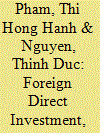

|
|
|
| 19 |
ID:
128008
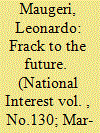

|
|
|
|
|
| Publication |
2014.
|
| Summary/Abstract |
THE WORLD has been caught by surprise by the United States' shale-oil boom. Analysts and experts are still clashing about both its true extent and the possibility of extending a shale revolution beyond North America. In just a few years shale oil could make the United States the world's top oil producer. But a shale revolution is unlikely in the rest of the world, due to some unique factors that characterize the U.S. oil and gas patch. The single-minded focus on the future of shale oil, however, risks obscuring another evolving dimension of the global oil picture that defies the past pessimism spread by peak-oil theorists who claimed that shortages loomed: beyond the United States, the world's oil-production capacity is also growing much faster than demand.
|
|
|
|
|
|
|
|
|
|
|
|
|
|
|
|
| 20 |
ID:
154532
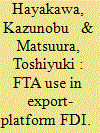

|
|
|
|
|
| Summary/Abstract |
Multinational enterprises (MNEs) actively use overseas affiliates to trade with third countries (i.e., neither the home country nor host country). In this paper, we empirically identify significant firm characteristics that influence the use of FTAs in export-platform Foreign Direct Investment (FDI). Specifically, we investigate the correlation of FTA use with: the share of "originating inputs"; intensity of exports to the third country; and experience using FTAs in exporting to other third countries. Then, we further investigate the difference in such characteristics according to the size of the parent company in order to clarify why the use of FTAs from platform countries is different between overseas affiliates owned by large firms versus small- and medium-sized enterprises (SMEs). To this end, we employ a unique dataset collected by the Japan External Trade Organization for 2012 and 2013. We found that Japanese affiliates owned by large parent firms are more likely to use FTA schemes in exporting than those owned by SMEs. In terms of Rules of Origin (ROO) compliance however, most affiliates owned by either SMEs or large parent companies have no difficulty because they already have a sufficiently high share of originating inputs. Therefore, we find that the major obstacle to FTA utilization concerns how to obtain certificates of origins (COOs) rather than complying with ROOs.
|
|
|
|
|
|
|
|
|
|
|
|
|
|
|
|
|
|
|
|
|